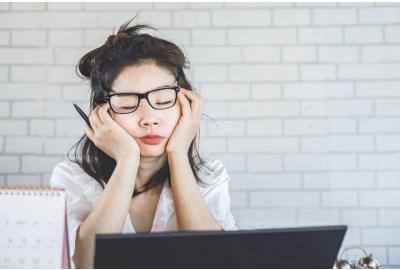Zoom Fatigue is Totally Real, But Here Are 7 Smart Ways to Beat it

After being urged to fling ourselves back into the workplace, many of us are facing a swift boomerang back to the home office and the dreaded dry-eyed, fuzzy-headed realm of Zoom fatigue.
You would think that a few extra smacks of the snooze button and a twenty step commute would make us feel less exhausted during office hours, but the seemingly endless carousel of video conferences leave many of us feeling absolutely run ragged by lunch time.
If you’re anything like me, this sudden drop in energy levels can leave you feeling somewhat concerned about your performance. How is it that you are adopting a steely laser focus in meetings, but feeling simultaneously sluggish and underproductive?
There is a complex cocktail of things at play here, but you’re not imagining things; the brain really is working much harder to decode and retain information in a video conference call than it would be in a physical meeting room.
Below are 7 reasons to explain just why your eyelids feel so leaden after a jam-packed Zoom schedule and some practical tips to silence your inner-critic and lighten the load.
1. I Feel Like I Have to Concentrate Twice as Hard to Really Understand What’s Going On
View this post on Instagram
Groping ineptly through German conversation was exhausting when I was living abroad and — even though they are very much in English — Zoom calls often give me a toe-curling sense of dejavu.
If you feel like you might spring an unexpected nosebleed from the sheer concentration needed to follow the tangled thread of a multi-person meeting, you are not alone. The culprit here is cognitive overload.
Focusing on a person shaped picture on your computer screen isn’t the same as talking to someone in real time, and your brain knows it. According to Dr Daria J Kuss, an associate professor in psychology at Nottingham Trent University, "You're missing out on physical cues you would normally have so it takes more cognitive activity to interpret what someone is saying and, in general, you need to be paying more attention."
Solution: Sadly, there is no way to effectively condense complex non-verbal social cues into a restrictive on screen rectangle, but a good way to limit the amount of brain power you are using to process conversations is to limit the amount of faces on screen.
Using ‘speaker view’ instead of ‘gallery view’ can really help as you will only have one face to focus on at one time, but if you find the constant flickering between speakers jarring, it can be really helpful to minimise the meeting and just listen.
Discarding the video input and simply focusing on the tone of voice can help you pick up more important details without being overwhelmed by superfluous visual information.
2. I Can’t Stop Looking at Myself!
Have you ever caught yourself constantly staring at your own face like a budgie in a mirror during a video call? Don’t worry, you’re not secretly a latent narcissist, everyone else is doing it too.
According to Cyberpsychologist Andrew Franklin, one of the reasons you might be gawking at yourself is because you are overwhelmed by the information flooding in from all angles. As the screen in front of us is finite, we are wrongly overconfident that we can process everything happening in the small space. When we can’t, we are drawn to focus on one thing, and that thing is often the familiarity of our own face.
Another reason we can’t stop looking at ourselves is imaginary audience phenomenon. In short, thinking that everyone is watching your face like a hawk because you are. In Franklin’s words:
“People become extremely self conscious and think that eyes are on them. When in reality, they’re not being scrutinised or criticised to the extent that they think they are.”
Solution: Sometimes the most simple solution is also the most effective, and the easiest way to stop scrutinising yourself and that thing your face does is to simply hide self-view.
It might take a little while for you to stop worrying about vetting the view which your colleagues can see, but it will soon be a case of out of sight, out of mind.
You can also suggest having some meetings with the camera off entirely, but be aware that it is off putting for the facilitator to be speaking into an abyss of silent, unmoving name tags!
3. I’m Stressed Out About How My Workspace Looks
It’s all too easy to be distracted by the domestic chaos that lurks just out of your webcam’s beady eye line, even if you’re certain nobody else can see it.
Smug articles about crafting a serene homeworking oasis can leave us feeling inadequate and it’s an uncomfortable reality that working from home has left us all operating in vastly different circumstances, where we were once united by a shared office.
Solution: Research has shown that the best Zoom backdrop for both you and your colleagues is a plain background, such as a painted white wall. This helps counteract sensory overload and also makes it easier for people to focus on what you are actually saying as opposed to your decor.
If it’s not possible to plonk yourself in front of a blank canvas, it might be worth experimenting with Zoom backgrounds so you feel less exposed to the sometimes invasive feeling of colleagues peeking into your home.
4. I Feel More Socially Anxious Than Usual
View this post on Instagram
It might feel absurd to suddenly break a sweat about speaking up when you're essentially in a room on your own, but there are many reasons why you might feel more ruffled than you usually would.
The performative element of Zoom calls drags you directly into the spotlight, even if you are only asking a casual question. Obviously, this is a totally unnerving situation as it would be unnatural and downright cruel to make you stand at the front of the room everytime you wanted to raise a point!
According to Marissa Shuffler, an associate professor at Clemson University, who studies workplace wellbeing and teamwork effectiveness:
“When you're on a video conference, you know everybody's looking at you; you are on stage, so there comes the social pressure and feeling like you need to perform. Being performative is nerve-wracking and more stressful.”
In short, a video call with a big audience “is like you're watching television and television is watching you”.
Solution: Unfortunately, there isn’t an enormous amount to be done here, but it can be helpful to rehearse what you want to say or write it down so you have a cue card to fall back on if the “all eyes on you” feeling leaves you feeling flustered. Alternatively, there is no harm in shooting a couple of questions off via email afterwards.
If you are leading the meeting, it goes without saying that you should prepare just as you would if you were in the office environment. It’s easy to gently slip into sloppier behaviour patterns in your natural habitat which can lead to the white-knuckle anxiety of the dreaded car-crash meeting. Oh, and dressing properly can really help you feel professional!
5. I’m Getting Headaches and Sore Eyes
View this post on Instagram
It’s common knowledge that staring at a screen all day can lead to a serious case of shrivelled raisin eyes, but our propensity to totally neglect breaks now the social element of work has been removed often goes unchecked and exacerbates the problems. Not to mention our less than perfect home office setups which lack the ergonomic integrity of many workplaces.
Solution: It’s easy to forget to take breaks when you're on your own, but those 5 min water cooler chats and little jaunts to Tescos that break up regular office life can really help with headaches and eye strain.
There's a high chance screen brightness might be too high, especially if you’ve been watching some dark and broody dramas recently, and putting a white piece of paper next to your screen and adjusting the brightness until it is a similar tone can really help. It's worth rememebering to adjust your screen brightness throughout the day as the light changes dramatically.
Posture makes all the difference to headaches and it’s worth investing in a good office chair instead of just making do with the one you dragged over from the dining room. It pains me to say it, but sometimes substance over style can pay off.
6. I Can’t Tell if the Points I’m Making are Getting a Positive Reaction From my Colleagues
It can feel impossible to know if your points are landing as well as they should be when you're squinting to scrutinise the expressions on thumbnail size faces. Not to mention the lags and delays that can plague virtual meetings and leave you feeling like a malfunctioning robot.
A 2014 study by German academics showed that delays on conferencing systems caused a negativity bias and that even delays of 1.2 seconds made people perceive the responder as less friendly or inattentive.
Solution: It can be helpful to check in with your audience regularly throughout a meeting or presentation, so you can accurately gauge the mood and engagement. Encouraging the use of reactions can also help. People love to use emojis, but without prior permission many colleagues might worry this is unprofessional and hold back, so let them know you're open to all the smiley faces and thumbs up that they can throw at you!
It’s also worth being mindful that losing your ability to read the room is just part of the Zoom landscape and you are not at fault.
7. I Find it Hard to be Heard
View this post on Instagram
If Zoom was a person, they would have the subtlety of a brick and nowhere is this more apparent than the mechanics behind which speaker gets priority. To put it bluntly, the loudest person wins the biggest screen.
Diversity and inclusion consultant, Sara Chandran, explains: “The person who speaks loudest can often command the most space on video calls because they can just ignore the others, so it makes it much harder for people who are anxious to participate.”
This also means those lower down the pecking order are less likely to speak up meaning valuable ideas are lost in the online ether.
As it is impossible for parallel conversations to take place on one audio stream, it can be anxiety inducing to try and figure out when to cut in without seeming dismissive and rude. In short, it’s exhausting.
Solution: It can be helpful to split people into ‘breakout rooms’ for discussions. These smaller groups can be set to run for a specified time period (10 mins for example), and they can help ensure that the quieter members of the group have their time to shine.
Agreed visual cues can also help facilitators and other colleagues know when somebody wants to speak, so it might be time to go retro and revise putting your hand up. If this feels too silly, there is a virtual hands up signal you can use, but it only works if everyone knows to look out for it.










